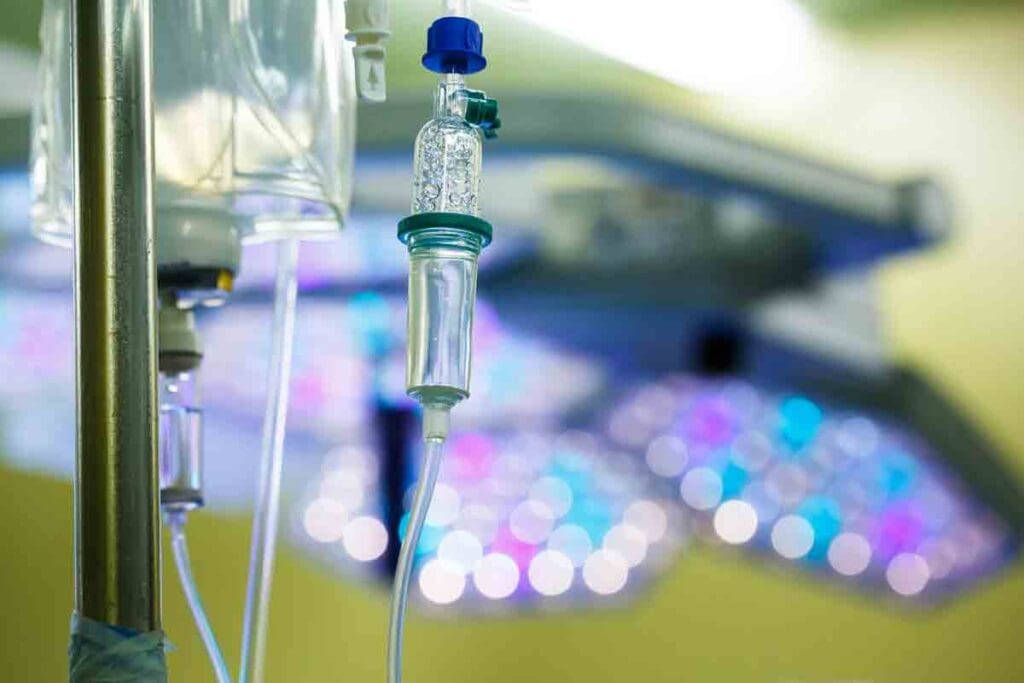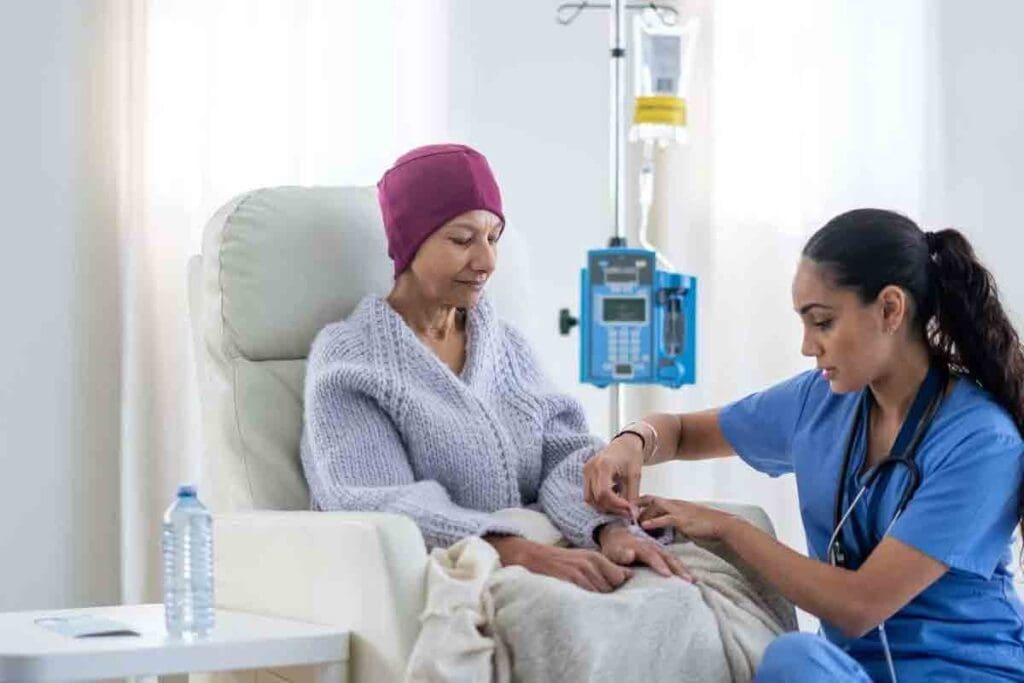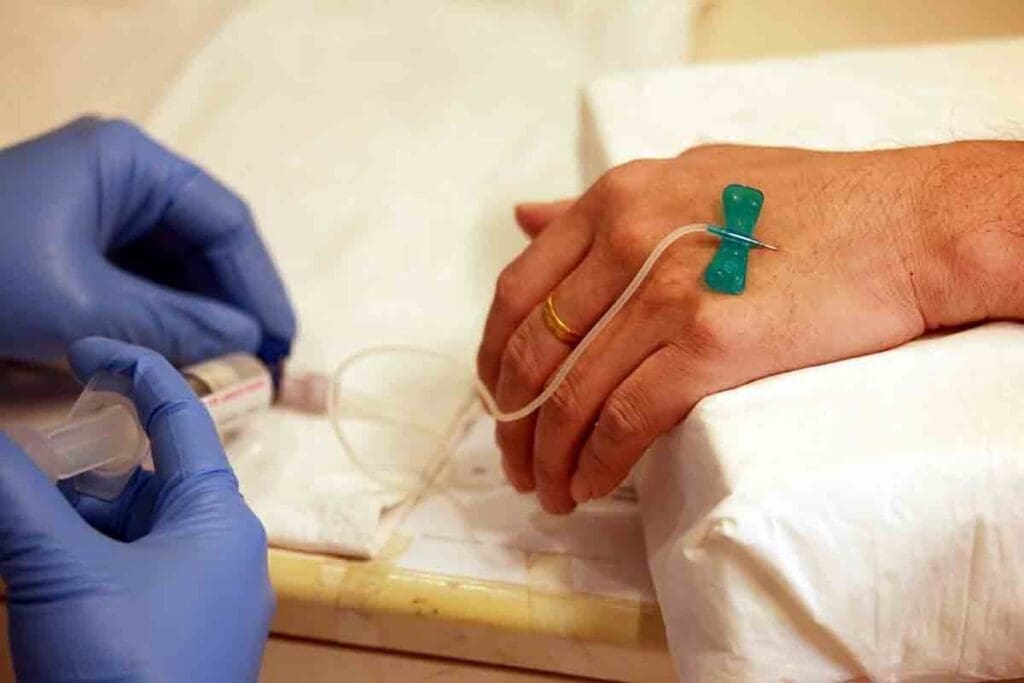Last Updated on November 20, 2025 by Ugurkan Demir

For those facing cancer, knowing the difference between chemotherapy vs radiotherapy is key. At Liv Hospital, we focus on both treatments to help you understand them better.
Chemotherapy uses drugs to fight cancer cells all over the body. On the other hand, radiation therapy uses beams to target cancer cells in one area. Knowing these differences helps you make better choices for your care.
We aim to give you the knowledge to make informed decisions about your cancer treatment.

It’s important to know about the different cancer treatments. These treatments are key in the fight against cancer. They offer various options based on each patient’s needs.
Cancer treatments are a big part of modern medicine. They give hope and help increase survival rates. Advancements in medical technology and research have led to many treatment options. These include chemotherapy and radiation therapy.
There are many reasons why different treatments are needed. A personalized treatment plan looks at the cancer’s type, stage, and the patient’s health. Some main treatments are:
Knowing about these treatments helps patients make better choices. This leads to better care and outcomes.

Cancer treatment has two main types: chemotherapy and radiation therapy. Each fights cancer in its own way. Let’s dive into how they help in cancer care.
Chemotherapy uses drugs to kill fast-growing cells, like cancer. It goes throughout the body, reaching cancer cells that have spread. It’s used when cancer has moved to other parts of the body.
Radiation therapy uses beams like X-rays to kill cancer cells. It focuses on specific areas where cancer is found. It can be used alone or with other treatments like chemotherapy.
Even though both aim to kill cancer cells, they do it differently. So, are chemo and radiation the same? No, they are not the same. They have unique ways to fight cancer.
It’s important for patients and doctors to know how chemotherapy works. It’s a treatment that uses drugs to kill cancer cells all over the body.
Chemotherapy stops cancer cells from growing and spreading. Cancer cells grow faster than normal cells, and chemotherapy targets these fast-growing cells. This can make tumors smaller, ease symptoms, and even cure some cancers.
There are many types of chemotherapy drugs. Each one works differently to fight cancer. Here are a few:
Chemotherapy can be given in different ways. It depends on the cancer type and the drugs used. Here are a couple of common ways:
Knowing how chemotherapy works, the different drugs, and how they’re given helps patients. It lets them understand their treatment better and make informed choices about their care.
Radiation therapy uses powerful beams to harm cancer cells’ DNA. This stops them from growing. It’s a key part in fighting cancer, focusing on killing tumors.
Radiation therapy targets cancer cells’ weakness to radiation. High-energy beams, like X-rays or protons, hit the tumor. This stops cancer cells from growing, while sparing healthy tissues.
Several types of radiation are used:
Radiation can be given in different ways:
Knowing how radiation therapy works helps patients understand its complexity. It shows the precision and care in cancer treatment.
It’s important to know the differences between chemotherapy and radiation therapy when facing cancer treatment. These treatments aim to fight cancer but work in different ways. They have different uses and effects on patients.
Chemotherapy targets cancer cells all over the body. It uses drugs that travel through the blood to find and kill cancer cells. Radiation therapy, on the other hand, focuses on a specific area of the body. It uses high-energy rays to kill or slow cancer cells.
This difference affects how these treatments are used. They can be used alone or together, based on the cancer type and stage.
Chemotherapy and radiation therapy have different schedules. Chemotherapy is given in cycles, with breaks in between. The number of cycles depends on the cancer type, the drugs used, and how well the patient responds.
Radiation therapy is given daily, Monday to Friday, for weeks. The exact time depends on the cancer type, stage, and treatment goals.
Chemotherapy and radiation therapy use different equipment. Chemotherapy uses drugs given through IV lines or orally. Radiation therapy uses machines like linear accelerators to deliver precise radiation to tumors.
Chemotherapy and radiation therapy have different goals. Chemotherapy can shrink tumors before surgery or kill remaining cells after surgery. It can also control symptoms in advanced cancer. Radiation therapy aims to treat localized tumors, either alone or with chemotherapy, to cure or control cancer.
To show the differences and similarities, let’s look at a table:
| Treatment Aspect | Chemotherapy | Radiation Therapy |
| Treatment Scope | Systemic | Localized |
| Method of Action | Drugs targeting rapidly dividing cells | High-energy rays killing cancer cells |
| Treatment Frequency | Cycles with recovery periods | Daily, Monday to Friday, for several weeks |
| Equipment Used | IV lines, oral medication | Linear accelerators, radiation machines |
| Primary Treatment Goals | Shrink tumors, kill remaining cells, control symptoms | Treat localized tumors, cure or control cancer growth |
Understanding these differences helps patients and doctors make better treatment choices. It ensures the treatment fits the individual’s needs and situation.
It’s important for patients to know about chemotherapy side effects. This treatment kills fast-growing cancer cells but can harm healthy cells too. This leads to various side effects.
Short-term side effects happen during or right after treatment. Common ones include:
Some side effects can last long after treatment ends. These may include:
Managing side effects well is key to a better life during treatment. This can involve:
| Strategy | Description |
| Lifestyle Changes | Dietary adjustments, gentle exercise, and stress management. |
| Supportive Care | Medications and therapies to alleviate specific side effects. |
By understanding and managing chemotherapy side effects, patients can better navigate their treatment journey.
Radiation therapy is a common treatment for many cancers. It comes with its own set of side effects. These can vary a lot from person to person.
Short-term side effects include fatigue, skin irritation, and hair loss in the treated area. These effects are usually temporary and go away after treatment ends. A leading oncologist says, “The skin care during radiation therapy is key. Gentle care can help reduce discomfort.”
Some patients may face long-term side effects like fibrosis or secondary cancers. It’s important to understand these risks when deciding on treatment.
Managing radiation side effects can greatly improve a patient’s life. This includes proper skin care, managing fatigue, and getting enough nutrition. A patient advocate says, “Teaching patients how to manage side effects is a big part of cancer care.”
By understanding and managing radiation therapy side effects, patients can better handle their treatment journey.
The choice between chemotherapy and radiotherapy depends on several factors. These include the type and stage of cancer. We consider various elements when deciding the most appropriate treatment modality for our patients.
Chemotherapy is often recommended for cancers that have spread or are likely to spread. It is also used for cancers that are sensitive to chemotherapy drugs.
Radiation therapy is typically used for localized tumors or cancers confined to a specific area. It can be used alone or in combination with other treatments.
Several factors influence the decision between chemotherapy and radiation therapy. These include the cancer type, stage, and the patient’s overall health.
| Factor | Chemotherapy | Radiation Therapy |
| Cancer Type | Systemic cancers like leukemia | Localized tumors like early-stage breast cancer |
| Cancer Stage | Often used for advanced stages | Used for early-stage or localized cancers |
| Patient Health | Consideration of overall health and possible side effects | Assessment of the tumor’s location and surrounding tissue |
We use these factors to tailor the treatment to the individual patient’s needs. This ensures the best possible outcome.
Radiation and chemotherapy are key in fighting breast cancer. But, they are used in different ways. The choice depends on the cancer’s stage, type, and the patient’s health.
Radiation is often chosen for early-stage breast cancer. It’s used after a lumpectomy to kill any leftover cancer cells. It also helps with pain in advanced stages.
Chemotherapy is best for cancer that has spread to lymph nodes or other areas. It’s also used for aggressive types of breast cancer.
Many times, both radiation and chemotherapy are used together. This is good for patients with big tumors or a high risk of cancer coming back.
New studies show great results with advanced radiation and chemotherapy. For example, intensity-modulated radiation therapy (IMRT) targets tumors better, cutting down side effects. New chemotherapy methods, like nanoparticle-based delivery systems, are also showing promise.
We’re always learning more about breast cancer and how to treat it. This gives hope to patients all over the world. By making treatment plans fit each person’s needs, we can help them live better and longer.
Combining chemotherapy and radiation therapy is a powerful way to fight cancer. This method uses the strengths of both treatments to better target cancer cells.
Using both chemotherapy and radiation therapy can improve treatment results. Chemotherapy kills cancer cells that have spread, while radiation therapy focuses on specific cancer areas.
This approach can lead to better tumor control, higher survival rates, and help keep organs working. Let’s look at these benefits in a table:
| Benefit | Description |
| Improved Local Control | Combining treatments can more effectively reduce tumor size and prevent local recurrence. |
| Enhanced Survival Rates | By attacking cancer cells both systemically and locally, combination therapy can improve overall survival. |
| Organ Preservation | In some cases, combination therapy can help preserve organ function by reducing the need for surgery. |
While combination therapy has many benefits, it also has challenges. Patients may face more side effects because of both treatments.
Dealing with these side effects requires a team effort. Supportive therapies help improve the patient’s quality of life during treatment.
Many cancers, like breast cancer, head and neck cancers, and some lymphomas, are treated with combination therapy.
The order of chemotherapy and radiation therapy can differ. Sequential treatment means one therapy comes after the other. Concurrent treatment means both are given at the same time.
The choice depends on the cancer type, its stage, and the patient’s health.
The world of cancer treatment is changing fast. We’re seeing big steps forward in chemotherapy and radiation therapy. This brings new hope to people all over the world.
New developments in chemotherapy include targeted therapies. These therapies aim at specific cancer cells, protecting healthy tissues. A top oncologist, believes the future of chemotherapy is in custom treatments for each patient.
Radiation therapy is getting better too. Now, we have proton therapy, which sends radiation straight to tumors. This cuts down damage to nearby tissues, making treatments more effective and less harsh.
These new methods are changing how we decide on treatments. With better and less invasive options, patients and doctors can make smarter choices. The American Cancer Society says, “New technologies and therapies are changing cancer care for the better.”
It’s important to know the differences between chemotherapy and radiation therapy for those facing cancer. We’ve looked at how they work, their uses, and their effects on the body.
Both treatments are effective against different cancers. Chemotherapy uses drugs to fight cancer cells everywhere in the body. Radiation therapy, on the other hand, uses high-energy rays to target specific areas. The right choice depends on the cancer type, stage, and the patient’s health.
New advancements in chemotherapy and radiation therapy have made treatments better and less harsh. Healthcare providers can tailor care by combining these therapies or adding other treatments. This approach helps patients get the best care possible.
As we keep improving cancer treatments, it’s key for patients to stay informed. Working closely with their healthcare team helps patients choose the best treatment. Knowing about chemotherapy and radiation therapy empowers patients to make informed decisions and face their treatment journey with confidence.
No, chemo and radiation are not the same. Chemo uses drugs to fight cancer cells all over the body. Radiation therapy uses beams to target cancer cells in a specific area.
Chemotherapy targets cells all over the body. Radiation therapy focuses on a specific area with high-energy beams.
No, radiotherapy and chemotherapy are different. Chemo uses drugs to kill cancer cells. Radiation therapy uses beams to destroy cancer cells.
Chemotherapy is a body-wide treatment. It targets fast-growing cells and can cause wide-ranging side effects. Radiation therapy is focused on a specific area. It has different side effects based on where it’s used.
Chemotherapy is often chosen for cancers that have spread. It’s also used for cancers that respond well to it.
Radiation therapy is preferred for cancers in one area. It’s used to shrink tumors before surgery or to ease symptoms.
Yes, chemotherapy and radiation therapy can be used together. This is called combination therapy. It’s used for some cancers and can be more effective.
Chemotherapy can cause hair loss, nausea, and fatigue. Radiation therapy can cause skin irritation and fatigue, depending on the area treated.
Decisions are based on the cancer type and stage, and the patient’s health. Doctors consider these to choose the best treatment.
New drugs and targeted therapies are improving chemo. Radiation therapy has seen advances like proton therapy and IMRT. These are making treatments better and reducing side effects.
Subscribe to our e-newsletter to stay informed about the latest innovations in the world of health and exclusive offers!